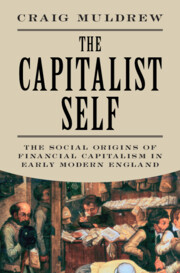Refine search
Actions for selected content:
210 results
Chapter 12 - Ankh-Morpork, Anti-Utopia
- from Part IV - Case Studies
-
-
- Book:
- The Cambridge Companion to British Utopian Literature and Culture since 1945
- Print publication:
- 31 December 2025, pp 244-269
-
- Chapter
- Export citation
Does Adam Smith Have a Theory of Money?
-
- Journal:
- Social Philosophy and Policy / Volume 42 / Issue 2 / Winter 2025
- Published online by Cambridge University Press:
- 16 December 2025, pp. 434-454
- Print publication:
- Winter 2025
-
- Article
-
- You have access
- Open access
- HTML
- Export citation
Real and Nominal Prices in Smith
-
- Journal:
- Social Philosophy and Policy / Volume 42 / Issue 2 / Winter 2025
- Published online by Cambridge University Press:
- 16 December 2025, pp. 416-433
- Print publication:
- Winter 2025
-
- Article
- Export citation
Chapter 6 - Money as Moral Calculus
- from Part II - Ethnography
-
- Book:
- Shapes in Revolution
- Published online:
- 07 November 2025
- Print publication:
- 20 November 2025, pp 170-206
-
- Chapter
- Export citation
14 - Making Money
- from Part IV - Realities
-
- Book:
- The Artist's Life
- Published online:
- 04 November 2025
- Print publication:
- 20 November 2025, pp 96-103
-
- Chapter
- Export citation
2 - Value in Motion: The Inheritance of Merchant Capital and Debates over Credit
-
- Book:
- The Capitalist Self
- Published online:
- 12 October 2025
- Print publication:
- 30 October 2025, pp 57-100
-
- Chapter
- Export citation
Jane Austen, Law Professor, on Bar Prep: Four Stress-free Lessons on Estates in Land and Family Law
-
- Journal:
- International Journal of Legal Information / Volume 53 / Issue 3 / Winter 2025
- Published online by Cambridge University Press:
- 20 October 2025, pp. 199-209
- Print publication:
- Winter 2025
-
- Article
- Export citation

The Capitalist Self
- The Social Origins of Financial Capitalism in Early Modern England
-
- Published online:
- 12 October 2025
- Print publication:
- 30 October 2025
7 - Money, Credit and Banking
-
- Book:
- An Economic History of Europe
- Published online:
- 02 October 2025
- Print publication:
- 02 October 2025, pp 155-177
-
- Chapter
- Export citation
Chapter 15 - Money (and Mythos)
- from Part IV - Paradoxes and Predicaments
-
-
- Book:
- Schoenberg in Context
- Published online:
- 04 September 2025
- Print publication:
- 04 September 2025, pp 153-162
-
- Chapter
- Export citation
Chapter 7 - Plato
-
- Book:
- Aggregation and Antithesis in Ancient Greece
- Published online:
- 21 October 2025
- Print publication:
- 28 August 2025, pp 173-190
-
- Chapter
- Export citation
Broad Divisia money, supply pressures, and U.S. inflation following the COVID-19 recession
- Part of
-
- Journal:
- Macroeconomic Dynamics / Volume 29 / 2025
- Published online by Cambridge University Press:
- 22 August 2025, e133
-
- Article
-
- You have access
- Open access
- HTML
- Export citation
‘A little bit of empathy and compassion would go a long way’: emotional and psychosocial experiences of money management and cognitive decline in later life
-
- Journal:
- Ageing & Society / Volume 45 / Issue 12 / December 2025
- Published online by Cambridge University Press:
- 12 August 2025, pp. 2774-2796
- Print publication:
- December 2025
-
- Article
-
- You have access
- Open access
- HTML
- Export citation
Politics in a theory of money: A reply to Dietsch et al.
-
- Journal:
- Finance and Society / Volume 11 / Issue 3 / December 2025
- Published online by Cambridge University Press:
- 11 August 2025, pp. 476-481
-
- Article
-
- You have access
- Open access
- HTML
- Export citation
Chapter 7 - The Economy in the Feyerabend Lecture Notes on Natural Right
-
-
- Book:
- Kant's Lectures on Political Philosophy
- Published online:
- 18 July 2025
- Print publication:
- 07 August 2025, pp 122-141
-
- Chapter
- Export citation
6 - Financial Administration, Market, and Merchants
- from Text 6 - Regulating Markets and Government Grain Purchases
-
-
- Book:
- Chinese Statecraft
- Published online:
- 17 July 2025
- Print publication:
- 31 July 2025, pp 96-112
-
- Chapter
- Export citation
Chapter 15 - Multiculturalism and the Many Meanings of Money
- from Part II - Histories
-
-
- Book:
- Money and American Literature
- Published online:
- 03 July 2025
- Print publication:
- 17 July 2025, pp 256-273
-
- Chapter
- Export citation
Chapter 13 - The Logics and Rhetorics of Theft in 1970s Feminist Writing
- from Part II - Histories
-
-
- Book:
- Money and American Literature
- Published online:
- 03 July 2025
- Print publication:
- 17 July 2025, pp 223-239
-
- Chapter
- Export citation
Introduction
-
-
- Book:
- Money and American Literature
- Published online:
- 03 July 2025
- Print publication:
- 17 July 2025, pp 1-22
-
- Chapter
- Export citation
Chapter 5 - Reckoning with Money in the American Renaissance
- from Part II - Histories
-
-
- Book:
- Money and American Literature
- Published online:
- 03 July 2025
- Print publication:
- 17 July 2025, pp 94-108
-
- Chapter
- Export citation
